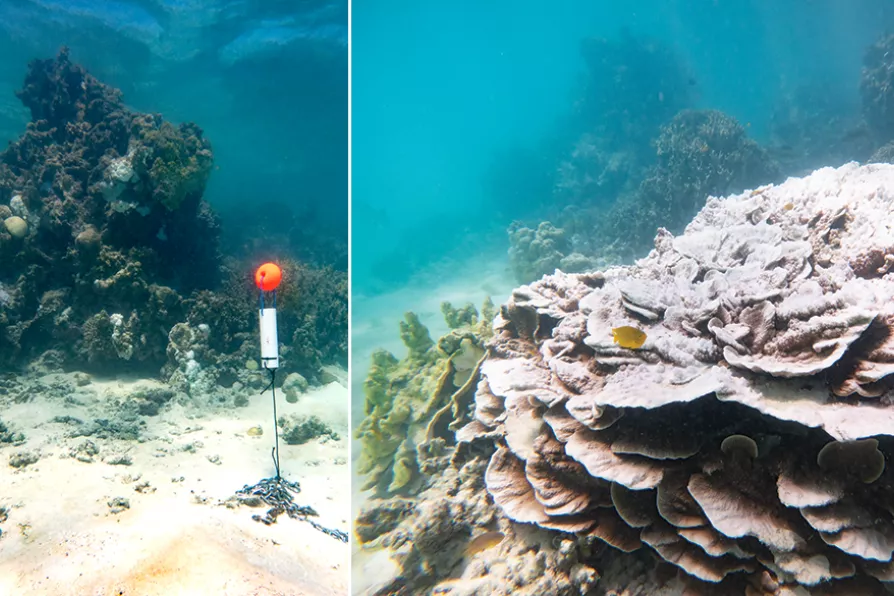As Labour continues to politically shoot itself in the foot, JULIAN VAUGHAN sees its electorate deserting it en masse

 ARMAGEDON: (L to R) Bleached plate coral at One Tree Island, Great Barrier Reef; Temperature logger in situ, both pics April 2024
ARMAGEDON: (L to R) Bleached plate coral at One Tree Island, Great Barrier Reef; Temperature logger in situ, both pics April 2024
CORALS are symbiotic, meaning they depend on a relationship with another biological organism. Microbes called zooxanthellae live inside the structures corals build out of calcium carbonate.
The microbes photosynthesise, providing corals with energy and nutrients. They also give corals their characteristic vivid colours. However, when corals are placed under stress, they will expel their resident zooxanthellae, turning the coral white.
By far the most serious cause of this stress-related bleaching is warming water. Corals have a typical temperature range they are happy with, and when water temperatures exceed that — particularly for long periods — they bleach.
The bleaching is not merely an aesthetic concern: the expulsion of the zooxanthellae means the corals have lost their main source of food. They may not initially die but they are vulnerable, susceptible to disease and starvation. Longer periods of bleaching and they will die.
When the water temperature becomes too hot, a colourful reef can be transformed into a graveyard. The tropical paradise disappears; as corals die and turn white, a brown algal sludge spreads.
Climate change is driving hotter oceans and causing mass coral bleaching with increasing frequency. In the first four months of 2024 alone, more than half of all coral reefs worldwide will have experienced water temperatures high enough to cause bleaching.
The Great Barrier Reef is perhaps one of the starkest examples of this devastation. On April 17, the Australian government published a report on the status of the coral that makes up the Great Barrier Reef. It is a depressing read.
The Great Barrier stretches over two thousand kilometres and is composed of thousands of individual reefs. Aerial surveys conducted in February and March of this year (during the Australian summer) showed widespread bleaching, affecting three-quarters of the reef. Worse, nearly two in five reefs had more than 60 per cent of their coral cover bleached ghostly white. The further south in the reef, the worse the damage.
It seems that this bleaching event is the worst yet, but the pattern is nothing new. The Great Barrier Reef is bleaching more frequently: mass bleachings have already occurred in 2016, 2017, 2020 and 2022. The quick succession is unprecedented. And more are surely on the way, given the continuing rise in global mean temperatures.
If the world successfully meets the 2015 Paris Agreement’s most optimistic targets, global mean temperatures will increase by 1.5°C. The IPCC projects that at this temperature, at least 70 per cent of tropical and subtropical coral reefs will be lost. At this stage, it’s worth stressing that this would represent an almost unimaginably good outcome.
Money has been spent on projects to mitigate against bleaching such as seeding reefs with coral grown in aquariums.
Coral biologist Terry Hughes argues that these attempts are probably doomed to fail. “After 50 years of interventions, coral restoration attempts have not changed the ecology of a single reef anywhere,” he has said. “They’re just too small in scale.”
He points out that to artificially increase coral cover in the Great Barrier Reef by 1 per cent would need 250 million individual corals each the size of a dinner plate. That volume of coral simply can’t be grown in aquariums.
[[{"fid":"64595","view_mode":"inlinefull","fields":{"format":"inlinefull","field_file_image_alt_text[und][0][value]":"DEADLY THREAT: Bleached corals at low tide, Great Barrier Reef, April 2024 Pic: John Turnbull/flickr/CC"},"type":"media","field_deltas":{"1":{"format":"inlinefull","field_file_image_alt_text[und][0][value]":"DEADLY THREAT: Bleached corals at low tide, Great Barrier Reef, April 2024 Pic: John Turnbull/flickr/CC"}},"link_text":null,"attributes":{"alt":"DEADLY THREAT: Bleached corals at low tide, Great Barrier Reef, April 2024 Pic: John Turnbull/flickr/CC","height":"495","width":"660","style":"width: 660px; height: 495px;","class":"media-element file-inlinefull","data-delta":"1"}}]]
Hughes and other marine scientists like Ove Hoegh-Guldberg have received death threats because they are adamant in linking bleaching to climate change.
It’s not only higher water temperature that harms coral reefs. Over the past few months extreme rainfall in northern and central Australia caused rivers to flood. The rivers then poured out into the sea in flood plumes, likely damaging the coral with the extra freshwater and sediments they carried.
Two cyclones also passed across the Great Barrier Reef, generating large waves that damaged coral.
None of these events are “unnatural” in isolation. But the frequency and pace of the battering of the Great Barrier Reef by all these different stresses is driven by climate change caused by fossil fuel emissions. Given time, reefs can recover, but that’s what they don’t have.
Hughes told Nature that reef ecosystems were “transforming into a new configuration” because of the death of coral. It seems likely that reefs will have less coral overall as well as lower diversity of coral species and more seaweed.
The knock-on effects on other species in the reef are difficult to be confident about, but sadly we will find out all too well what those are over the coming years.
Mass bleaching events cause horror across the political spectrum and make a mockery of our attempts to protect coral reefs through other means. For example, the Flower Garden Banks are a set of spectacular coral reefs on top of submerged salt domes in the Gulf of Mexico which are protected by a US National Marine Sanctuary.
A campaign to expand the sanctuary was spearheaded by Clint Moore, a Republican petroleum engineer with a “deep passion” for coral reefs.
On Trump’s second-to-last day in office in 2020 he increased it by 160 square miles. However, Trump’s “expansion” was in fact a drastic contraction of the proposed plans. The stated reason: to reduce potential economic impact on the oil and gas industry.
The coral-lover Moore was the representative for Oil and Gas Production on the Sanctuary’s advisory council. With coral-loving allies like these, who needs enemies?
It is easy to feel misanthropic. In 20,000 Leagues Under the Sea (1870) by Jules Verne, the narrator who travels aboard Captain Nemo’s submarine is fascinated by “those curious polypi of which entire islands are formed.” He describes his theory that coral islands off the coast of Australia could, given sufficient time, be joined together into a “fifth continent” which will stretch from New Zealand to New Caledonia. When he suggests this theory to Captain Nemo, the reply is cold: “The Earth does not want new continents, but new men.”
Yet we have to believe in collective action, because there is nothing else. While coral can slowly build a vast reef through microscopic increments, it is worth emphasising that thousands of small and individual actions from each of us will not suffice to avert catastrophic global warming.
As the physicist David Mackay once wrote, “If everyone does a little, we’ll achieve only a little.” In order to safeguard the future of the Great Barrier Reef as we know it, we need action at the level of states, with massive investment away from fossil fuels. There is no alternative.

The distinction between domestic and military drones is more theoretical than practical, write ROX MIDDLETON, LIAM SHAW and MIRIAM GAUNTLETT

Nature's self-reconstruction is both intriguing and beneficial and as such merits human protection, write ROX MIDDLETON, LIAM SHAW and MIRIAM GAUNTLETT

A maverick’s self-inflicted snake bites could unlock breakthrough treatments – but they also reveal deeper tensions between noble scientific curiosity and cold corporate callousness, write ROX MIDDLETON, LIAM SHAW and MIRIAM GAUNTLETT
Science has always been mixed up with money and power, but as a decorative facade for megayachts, it risks leaving reality behind altogether, write ROX MIDDLETON, LIAM SHAW and MIRIAM GAUNTLETT














